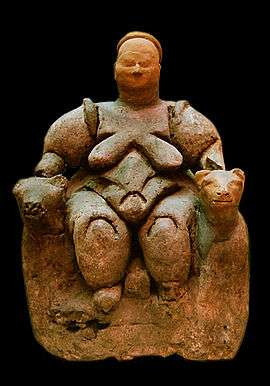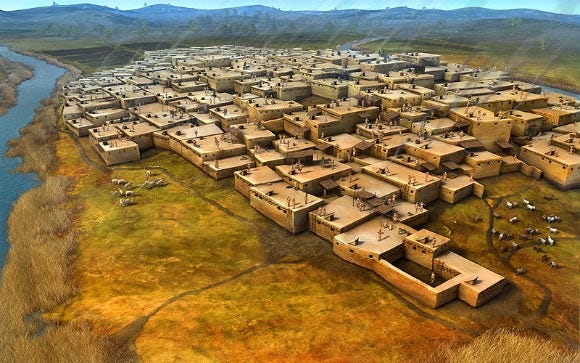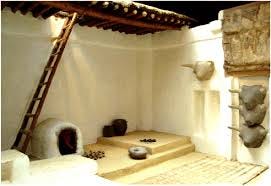Misogyny, Terrorism and the Manosphere (MTM) No. 2
No, there hasn't always been a patriarchy.
There she sits—calm and balanced. Her hands rest on the heads of “big cat” felines—lionesses, leopards, or panthers—in the act of giving birth. This figurine, of baked clay, is 8,000 years old and comes from a place called Çatalhöyük in what is now Türkiye. And the significance of this figuring and the ancient place from which it came cannot be overstated in the understanding that there was not always a patriarchy on this planet.
This article is free—but this series on misogyny and its relationship to terrorism and the rise of the manosphere, which deeply threatens the health and safety of women in government and society will be for paid subscribers only after we begin our new series THE PATRIARCHY in which we discuss historical fact and present conditions for both men and women—as well as Musk’s embrace of Andrew Tate and Peter Thiel’s complaint about women having the vote.
There are multiple reasons for this, mainly that both MAGA activists and anti-feminists attack viciously when we publish articles like this one, and requiring payment will result in fewer attacks (and waste less of our time). And, though writers write no matter what, there’s still the rent to pay. Please upgrade now, and please pass us along to women—and the wonderful men who support us—who will want to read these articles and participate in future Zoom conferences and interviews.
So THE PATRIARCHY is coming soon. We’ll begin with an extraordinary post about the biblical story of the Garden of Eden and a review of The Mythology of Eden by Arthur George and Elena George. This story is not what you have ever heard it is. It is not God’s word. It is a deliberate polemic and a conscious power-grab from an egalitarian culture to make a male-centered religion, and it worked.
So, coming soon.
The “Seated Woman of Çatalhöyük” may represent many things:
First, she may—and may not—represent a fertility goddess in the act of giving birth. As we’ll discover as this series continues, God wasn’t always male in human conception. In fact, the masculinization of God, in historical terms, is a recent event. Ancient religions, like that of Egypt and the cultures of the Fertile Crescent, had both goddesses and gods. And the morphing of culture—not from a matriarchy in which women bullied men but from egalitarian culture to male domination—took hundreds of years, even, perhaps, most of a millennium. The development of monotheism, which elevated the male to God status, follows the development of empire, with the top position held by the most dominant male. So, the king couldn’t be a dominant male and have a religion in which the female was equal. Voila! Patriarchy.
Second, Çatalhöyük represented an egalitarian, gylanic culture. And the Seated Woman may also have represented a mature woman—perhaps a crone—who had risen to a position of high responsibility and respect in the culture.
Let’s have a look at one of the oldest, and best-preserved human settlements for clues as to how these people lived. It may not be what you think—and it’s certainly not what you have now.
Çatalhöyük … pronounced Cha-Tal-Hay-OOK’
She lies in southeastern Anatolia, near the present-day Turkish city of Konya, about 90 miles from the double volcano Hasan Dağ. She lies on the Çarşamba Stream, standing on fertile terrain.
There are 18 different layers to the ruins of Çatalhöyük, with the earliest dating from c. 7500 BCE, making her as much as 8,900 years old.
Her beginnings, as you’d expect, were modest, but she grew from a hunter-gathered culture to one that raised crops and domesticated animals.
She’s odd. There are no streets here. The houses are built adjacent to each other with the rooftops serving as thoroughfares with people walking atop others’ homes in total freedom, dodging only the roof openings through which people moved in and out of the buildings—and the outlet through which the smoke from their fires, for cooking and for warming during the region’s very cold winters, escaped.
Despite the fairly uniform look of the settlement, which, by 7000 BCE may have contained as many as 8,000 people, a gully runs roughly down the middle of the city. Apparently this gully separated the two large intermarrying kinship groups—two family lines—that formed the city’s population. There seem to be no public buildings or government buildings, though later in the settlement’s history, there may have been large rooftop ovens that served communal feasts.
Was Çatalhöyük a Matriarchy?
When the swashbuckling English archaeologist James Mellaart, then of the University of Istanbul, discovered Çatalhöyük in 1958, it was an international sensation. Mellaart, who was eventually expelled from the country for black-market antiquities trafficking, claimed that the Seated Woman indicated ancient Mother Goddess at the site, implying matriarchy. Writes the BBC:
Known as the Seated Woman of Catalhöyük, or more popularly the Mother Goddess, she is a clay figurine of a corpulent woman sitting on a throne, flanked by two large leopards, who appears to be giving birth. As he continued his excavations Mellaart unearthed a treasury of female imagery and figurines that share a distinct resemblance to other Stone Age art going back 19,000 years – such as the famous Venus of Willendorf. That four-and-a-half inch figure, one of the oldest images of the human body yet found, was discovered in Austria near the Danube River. She too has exaggerated female features: pendulous breasts, a large belly and wide hips.
But was this early archaeology accurate in its conjectures?
Professor Ian Hodder, the leader of Catalhöyük's international team of archaeologists since 1993 has turned up more than 2,000 items, in contrast to Mellaart’s 200, and he found he disagreed:
Hodder insists [that[ the question should never have been posed as an either-or issue. He argues that his team’s discoveries are so much more significant than anything previously imagined. Catalhoyuk was a place were true gender equality flourished. An examination of male and female skeletons show that both sexes ate the same diet, performed the same work, and spent the same amount of time outdoors. In life, they inhabited the same physical space; in death they were given the same kind of burials. There is no evidence for either a patriarchal or matriarchal system. In Catalhöyük a woman’s biology was not her fate.
People have long accepted that political power is man-made rather than god-given. But it’s been different for female inequality. History, religion, science, everything in fact, has seemed to condemn feminism for being against the natural order. Thanks to Catalhöyük, we can say with confidence that there is nothing natural about patriarchy or matriarchy.
So, Çatalhöyük was neither a matriarchy nor a patriarchy but an egalitarian society where men and women had the same rights—and largely did the same work and ate the same food, as proved by their remains.
Neither gender disenfranchised, owned, or ran the affairs of the other. Some have argued that society in Çatalhöyük was anarcho-communist, but that is also untrue. Or, as the BBC sums up:
For the people of Çatalhöyük, there was no domination by either gender. These people, known for their richly symbolic religion and the spectacular art that adorned the walls of most dwellings, knew freedom.
Or, as the BBC sums it up:
Society can take many forms and shapes. Sex is genetic, but gender is cultural.
In the coming weeks British Museum archaeologist Rupert Chapman will join us for more discussion on egalitarian pre-patriarchal Neolithic cultures—and some spectacular examples from equatorial island cultures.
We will also be delving into the cultures of ancient Egypt, Mesopotamia, China, and Mesoamerica and explore the rise of patriarchy.
In addition, we will be doing deep studies of the current American Manosphere and the groups that threaten all women’s rights worldwide, with our first on the MRAs—men’s rights advocates—represented by Mike Johnson, Harrison Butker and Josh Hawley.
Be sure to join our mailing list as a paid subscriber to access this series after July 1st.
Meanwhile, here are a couple of links that may interest you.
Travis Kelce and Patrick Mahomes Give Butker's Misogynistic *Grooming Speech* a Pass on Religious Grounds
Everything Kelce and Mahomes—and National Public Airhead Whoopi Goldberg—need to know was stated by Martin Luther King, Jr. History will have to record that the greatest tragedy of this period of social transition was not the vitriolic words and the violent actions of the bad people bu…
Mike Johnson Summits the Mt. Olympus of Ego: Sees Himself as the "New Moses"
You can’t beat this for hubris—and you can’t match it for openness of intent—though Mike Johnson certainly meant to keep this hidden from people dedicated to the separation of Church and State. For these are comments Mike Johnson made at the gala of The National Association of Christian Lawmakers, which awarded Johnson the American Patriot Award for Chr…







Wow! What an interesting substack to read while my coffee settles in and perks up my drowsy brain! You’ve given me so many ideas to consider, and I’m thankful for your writing.
Fascinating stuff! I am all in! Can’t wait for next installment. Watching today Trump’s accelerating fall from Grace as he opens his mouth to speak and only deluded garbage emerges. Promises broken. That lawsuits are being filed quickly is so very hopeful. Now, how do we get those criminals pardoned off the streets before their toxic masculinity gets MORE people killed? HUGE MISTAKE!